Sun Dec 03 2023 19:10:00 GMT-0800 (Pacific Standard Time)
Introducing noise-arch radio. It's a thing I created.
It's a long-form audio stream of the items in the noise-arch cassette archive collection on archive.org.
Not everything in the collection is great, and some of it is obnoxious, but there are some real treasures in there as well! I find it fun to randomly "tune" in now and again to hear what's playing.
I calculated the total runtime from the metadata in the collection -- it's just over 2 weeks. In other words, the playlist will get re-shuffled about every 14 days. It's a lot of content.
I have no idea how many listeners it can support on such a small cloud instance, and I have given zero thought about scaling it. I assume nobody cares or actually wants to listen to this stuff, so whatever.
Tue Feb 21 2023 22:29:13 GMT-0800 (Pacific Standard Time)
tags: noise audio piezo microphones
Finally starting a process of building a small collection of ACTUALLY USABLE diy contact microphones.
The ones pictured here will have some strain relief before being plasti-dipped.
I've built these over the years, but never of any decent quality. In fact, I think the one I made
back in 2005 when I made the
Liar's Rail recording just had some exposed
solid-conductor twisted pair wire hanging off it (recycled phone cord or ethernet I think).
So any time in the last couple of years that I've reached for one in the parts bin it seems to always be screwed up and doesn't work right. That frustration plus a small surplus of discs remaining from Wacky Willy's days provoked this process.
It's purely an aesthetic choice, but I now totally love cables with nylon sleeves over them now. This is my first time actually hacking/reusing some cable like that. I think maybe the right thing to do is to buy the sleeving separately, but I got lazy and hurried into buying a longer prefab cable for reuse. It's fine and totally workable, but some cable does get wasted due to fraying. If you look carefully in the photo above, one of the mics has a larger black piece of heat shrink covering some area where the sleeve didn't stretch as much as I had expected. I think it won't matter much once it's dipped, but there's a learning process here for me.
Tonight was also my first attempt at recording directly from the contact mics with the Zoom H2n. The default mic power was enabled, and the sound was very clear and loud. Stoked it worked so well.
I intend to also build some other formats, like:
Sun Mar 13 2022 20:00:00 GMT-0700 (Pacific Daylight Time)
Last week was the fourth and final week for the experimental music course I've been taking. Due to being busy with other things, I had put off the "homework" for a week and got back to experimentation this weekend.
Last week's lesson was all about synth techniques. What a doozy! I feel like that's a very difficult subject to cram into a 90 minute session. Even if you can be certain that people have some exposure to basic signal theory and techniques, it's really difficult to describe a patch and there's definitely some problems around expecting people to have access to specific modules (are formant and shepherd filters that commonplace? lol). As an exhibition, it was very cool...but as a teaching/learning session, I think it was a bit of a stretch.
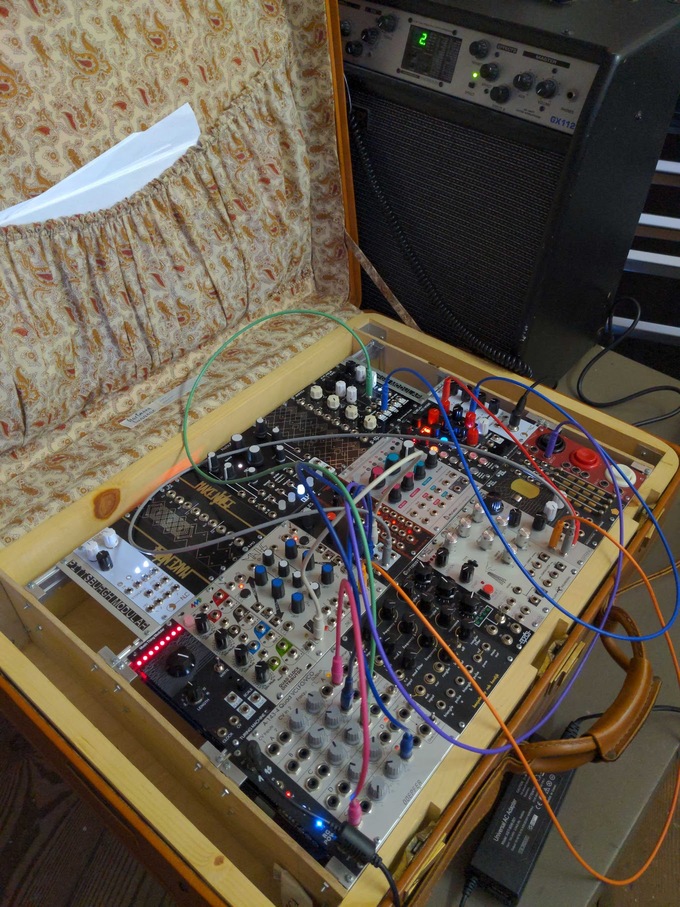
I did 3 or 4 different patches, one of which was strongly inspired by one of Jamie Stewart's example patches in the class (although I made a couple small tweaks). I took some of the session audio and arranged it into this rough track:
Direct links to files here: flac mp3
Honestly, in a pretty dark place while making these. Stoked with how they turned out, but the mix could use a lot of love, something that I'm not going to put time into right now though.
Sun Feb 27 2022 21:30:00 GMT-0800 (Pacific Standard Time)
tags: music noise percussion audio sound
This week's "homework" for the experimental music course was pretty deep and had 5 possible assignments. One of these was to compose and record a short piece of music using only percussion (using techniques covered in class).
I'm not really a percussionist, so this seemed like a good challenge. Here is the final recording of what I ended up putting together this afternoon. Give it a listen while you read about the process below.
I think I remember my brother telling me that he was in the music program at the University of Oregon with Ches Smith, and that Ches used to gig with a sawblade used as a crash or a bell or something. Since much of our course material involved really nice shiny percussion instruments that I definitely do not own, I figured I would still give it an honest attempt starting with this sawblade as inspiration. I had an old/used skill saw blade around, and started by suspending that from the rafter.
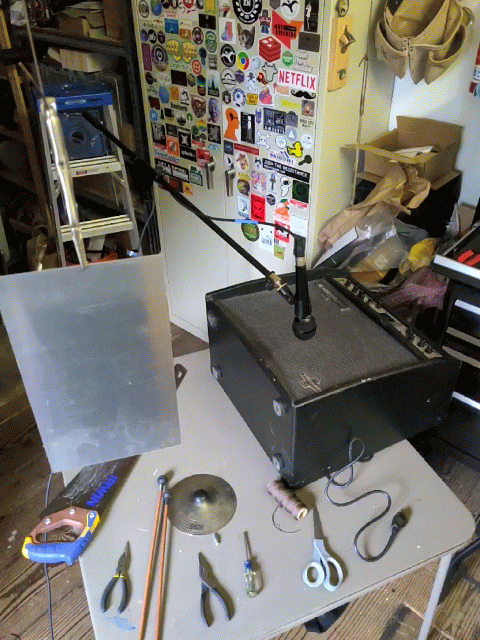
Initial experiments showed that it sounded pretty good and had a nice ringing bell sound. When a playing it close to the microphone, however, the swinging and spinning made it pretty hard to capture the sound. I ended up adding a second tie to prevent it from rotating, and that helped a lot.
I also suspended a piece of sheet aluminum that have cut up previously for making eurorack faceplates. I didn't want to drill holes in it, so I first tried to compression fit two nuts on a bolt on either side. That failed horribly and quite dangerously. :) I instead used needle-nose vice grips and suspended it via that. The rich gong sound from a simple flat rectangular piece of aluminum was pretty surprising (to me)!
I also had the brass frame from a decorative air plant holder that a friend had gifted me several years ago. That was already hanging in the shop, so I used that as well since it had a nice triangle sound.

I think I recorded like 14 or 15 tracks and ended up using these final 11:
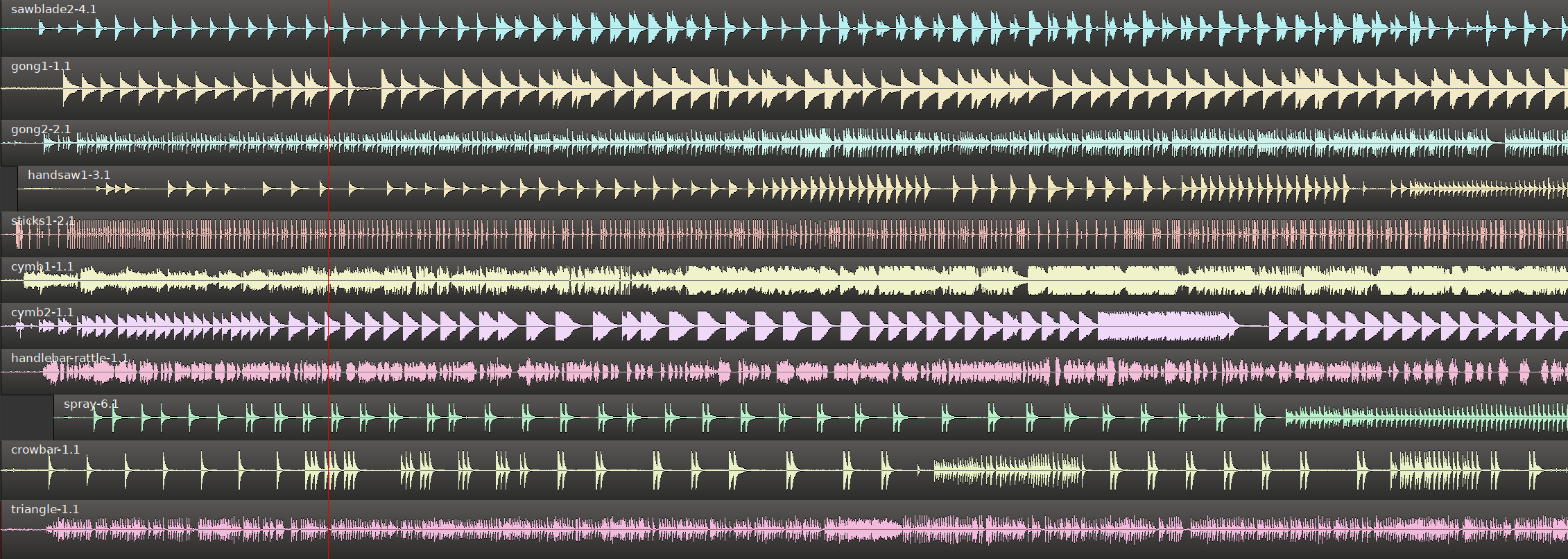
The track breakdown is something like this:
Aside from some pretty flagrant reverb on the sticks and a couple level adjustments, everything is just as I recorded it -- no edits, all timing mistakes are mine to own. As such, it is raw and could certainly using some mixing/equalizing at the very least, but I'm really happy with how it turned out.
Future improvements -- with more time, I hope to do some more experimentation with the sawblade, perhaps figuring out how to mount horizontally more like a cymbal. I will also experiment with adding loose screw/nut combinations to the blade to add some rattle or odd dampening. I think there is a notable lack of low-end bass in this work, and I've long wanted to experiment with tubular bass cannon type drums...so that would be another future experiment.
It was also clear from this experiment that the microphone I've used is wrong for this type of work. It's much much too directional and lots of tone was lost as the instruments changed their position or rotated. Something with a broader direction could have compensated for and possibly maintained some of the interesting tonal changes that were happening as things moved around (this was lost in process).
That's it for now. More homework later this week or next week!
Tue Feb 22 2022 21:30:00 GMT-0800 (Pacific Standard Time)
As I mentioned in the last blog, I'm taking a zoom course on Composing Experimental Music, we have optional "homework" assigned -- which is really a set of flexible techniques to experiment with and explore timbre.
In class, Jamie demonstrated several means of exploring amp feedback width stringed instruments (including the immediately recognizable autoharp!), and I really don't have any viable stringed instruments right now. I really wanted to make one out of scrap wood and rubber bands, but time didn't afford that this cycle (I hope to revisit sometime soon). It occurred to me that the springs inside the spring reverb tank might behave a little bit like oddly shaped "strings", so I performed some feedback experimentation.
In this experiment, I left the reverb tank input open, so all sound was internally generated through mechanical vibration of the springs -- either through externally tapping with hand or drumstick, or by the speaker vibrations resonating with the coils. This is what I had really hoped to explore.
I absolutely LOVE the industrial echoing machinery sounds of the spring reverb, but I wasn't going for that this time around.
I got some interesting resonances by playing with various effects settings and modulating the position of the tank and riding the effects controls (mostly volume).
From this experiment, I have put together one rushed/stupid video and one clip of excerpts.
I later set the amp on its back and had the tank sitting on the mesh facing down/vertical. This allowed me to adjust positions while being more able to monitor the effects controls with two hands. I worked with several varied effects modes, but mostly used the downward pitch shift in hopes of getting a lower frequency bass response and reducing the high-pitch static feedback tone that everybody can picture in their head right now.
It was a much longer session, but here are several edited excerpts:
Direct link is here: Homework 02b
I am pleased with the resonant tones/outcome of this experiment, and I believe that additional exploration with a bass cabinet or feeding back through a transducer (possibly through mechanical linkages of odd varieties) could yield even more interesting timbres.
Sun Feb 20 2022 00:30:00 GMT-0800 (Pacific Standard Time)
I'm taking Jamie Stewart's course on Composing Experimental Music, and it's already halfway through and I'm enjoying it tremendously. It's blazingly fast paced and is covering a TON of ground on so many varied topics really quickly.
All of the "homework" is optional and this course is just not for credit or anything, but one of the reasons I wanted to take it was to be exposed to some new possibilities and to nudge myself to do some more experimentation.
For the first assignment, I decided to dust off a synthesizer I built 20 years ago, the triwave picoswash. I ran it through a modeling amplifier that was scrounged from a dumpster that I later repaired (tho it's still fucked up, only one of the digits on the display is working). Jamie covered a little about frequency beating (not a new concept, but one I haven't explored much recently), so I decided to spend some time de/tuning the two sides of the triwave into giving some interesting beat patterns.
Of course, the triwave always sounds better when patched through the noise swash, and then I ran the amp in a reverb/delay mode with the parameters up basically all the way (tho it's hard to be sure with the broken display, heh).
So here's a brief clip from that session, just recorded on a phone:
The second class gave several assignments, and one of them involved capturing a field recording and then turning it into a composition using the DAW. It was a rather slow and mostly quiet Friday afternoon in my neighborhood, but I managed to get some sounds recorded and turned them into this piece here:
Here is the direct link to mp3 here: Homework 02a
I'm pleased with the way it turned out! I wanted to make some musique concrète while keeping some aspects of the source material clearly audible. I wanted it to sound like a field recording, but with some enhanced editing/mixing/structure/interest.
There are several more parts to the "homework" (all of it is optional, for fun/learning/experimentation), I have a bit more to finish up and share. More to come in a following blog entry.
Wed Apr 21 2021 23:24:24 GMT-0700 (Pacific Daylight Time)
It was very delayed (life gets in the way!)..., but we finally finished our split cassette.
This is Infiltration Lab on one side and Sun Tunnel on the other.
More information over here on infiltrationlab.com or on archive.org.
If you are interested in a tape, let me know.
Thu Apr 04 2019 20:45:00 GMT-0700 (Pacific Daylight Time)
tags: sound audio noise dryice experiment dorkbotpdx dorkbot pdx ^h
Earlier this month at the end of a Dorkbot meeting, somebody had a chunk of dry ice. I put it into the empty popcorn bowl and recorded it.
Click the link above or listen to it here:
Enjoy!
Sat Nov 17 2018 15:55:50 GMT-0800 (Pacific Standard Time)
tags: wcsb radio noise freeform cleveland archive archive.org
TL;DR - I archived 78 episodes (~150 hours) of a radio show and you can listen to them here.
It was probably 19 years ago that I discovered the FM station WCSB streaming on the internet. It was a special time, those Napster days when the internet still felt like something new...and most people were still on dialup or at best a home DSL connection. 1999 held all kinds of new opportunity to discover exciting things in a newly connected world...like finding an mp3 of a rare/hard-to-find b-side or having your head melted by stumbling into entirely new genres of music.
For me, listening to audio streams on shoutcast/icecast and direct from a few misc sources was a crucial part of that exploration/growth/discovery.
The "Noise Rotation" (sometimes fondly called the "noise rot") on WCSB was a 2-hour block of specialty programming that rotated its DJ/host each week. I have no idea when it started or ended, but I can say that it was alive at least from May 2000 through May 2002. I enjoyed listening to it because I could catch bands that I was familiar with (like Negativland and Foetus, for example) followed by a 40 minute wall of droney noise and shit that I'd never heard of. The freeform nature of the programming was really inspiring, and completely different from the college station I volunteered with. It seemed like they could get away with anything!
These days, many radio stations keep archives of their shows, and you can listen to them on your own time. Hell, some shows are just podcasts now that happen to also be broadcast on the FM band and the internet at certain times. But back then, storing and indexing and making a nonstop rotating archive of material was rarely feasible. Also, storage was expensive (a 20GB hard drive might have set you back about $120). For me, I just wanted to listen to shows on my own schedule...so I began recording.
I'm sure that I had a cron job set up to just begin recording the cbr stream and dump the output to a file (probably using wget or curl). Due to the somewhat chaotic nature of college/community radio and computer time drift, I started recording a few minutes before and let it run a few minutes late. Even then, I'm sure that I missed content.
I blogged about the Noise Rotation back in early 2001 and hadn't thought much about it since. At that time, I was excited to have edited down 24 hours of material by trimming and removing ads/commercials. I'd listen to a show every few years, but mostly since access to everything is so plentiful and the quality is greater, I didn't revisit it much.
I'm pretty sure that I stopped recording the show in May 2002 when we moved back to Oregon and just never set it back up.
This year I found the recordings again and decided that enough time had passed that others might now find them useful/fun/important/historical. I spent many many nights trimming the rest of the episodes and normalizing/preparing them for upload. I decided that in the interest of historical preservation and to expedite editing, that I would not remove any host chatter and I would leave all the station IDs and event announcements and disclaimers in place. I removed dead air a few times though. :)
In the process of working the recordings, there were a few interesting times...like the time where the prior (blues?) show just continued because the Noise Rot person didn't ever show up. I'm pretty sure daylight savings bit me on a couple of the recordings, and one of the hosts just talked more than he played music. I think the station went off-air at least one time as well.
The final result wasn't that much data by today's standards (only about 1.6GB), but I couldn't imagine creating each item by hand using the web interface on archive.org. Luckily, tools exist to help with this stuff, so I hacked up a script to help automate things. The first attempt at upload/archive failed after about 3 or 4 files due to automated spam throtting...but a quick email to a support admin at archive.org fixed things up and I was able to complete the process the next day.
I ended up having 78 usable recordings, which comprise about 157 hours of noise. Click here to enjoy or just click the logo above.
Mon Jan 02 2017 10:19:26 GMT-0800 (Pacific Standard Time)
I made some textures with a synthesizer in sub-zero temperatures. Pretty fun, even with just a small number of starter modules...
Fri Nov 13 2015 22:15:39 GMT-0800 (Pacific Standard Time)
tags: reblog noise backtothefuture
Wed Jul 15 2015 21:25:08 GMT-0700 (Pacific Daylight Time)
tags: synth eurorack noise synthesizer circuit
Trying out the whopping 4 modules I have installed...
Wed Feb 24 2010 00:53:44 GMT-0800 (Pacific Standard Time)
tags: infiltrationlab radio noise audio sound
Infiltration Lab played a live, hour-long drone/noise set on KBOO FM on February 1st, 2010.
In the unfortunate event that KBOO loses funding or they change their url scheme or de-archives material or bombs hit Portland or whatever, I have also archived the show on archive.org. Hopefully this embedded player continues to work:
A few random tech details: I played the set on my audiopint computer that I built a couple years ago, running some Pd patches that I designed specifically for this show. As usual, the computer (as underpowered as it is!) had no problems keeping up. All sounds in the recording were rendered through Pd in realtime. Some audio material (for the granular synthesis) was taken from a(n unnamed) commercial recording, and the spoken sample material was mixed blind (previously unheard by me) from a psychological tape sourced at the Goodwill bins.
This piece is intended to be a contrast of sorts, a juxtaposition, and an overt psychological response to the reflection of time collapse. There really is no time. If your current self could revert to its earlier self in an instant, what would that event sound like?
Many thanks to Sean for having me. May radio live on!
Wed Jun 24 2009 22:59:18 GMT-0700 (Pacific Daylight Time)
Sometimes when bogged down by responsibility I can find it rejuvenating to embrace the right kind of distraction.
So my distraction involved hearing a radio cut of the Billy Idol hit "Cradle of Love" and finally following thru on a long-time desire to cut the thing into its most fundamental (read: important) parts: The grunts.
"That's right!" Sir Cyborg Himself. Despite having such a HUGE hit in the 90s, there are probably between zero and 3 people on the planet who actually know all the lyrics -- it's a slurred bozo fest of nonsense sexual innuendo and rockstar spittle. Simply brilliant.
So I leave you with "Rock The Cradle of Love Grunts".
Mon Nov 26 2007 00:13:16 GMT-0800 (Pacific Standard Time)
tags: infiltrationlab noise pd puredata music
After more than a year, Infiltration Lab has released a new 3" CDR.
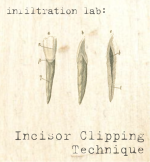
As always, mp3 audio is freely available for download from from archive.org. (Although apparently right now there's a problem with the post, ug. Will update later when the dust settles...sorry).
This little abstract recording is a 22 minute trek into the insufferable human psyche. It was composed mostly for several pure data (pd) patches and instruments (like the cracklebox and atari punk console) that I built earlier this year. The foldout covers are printed in full color, and the CD labels were each individually hand drawn and painted.
All things considered, I'm pleased with the final recording product. I do wish I would have spent more time on the final mix (the sound/range is a bit low, so crank it up loud!) and made things a bit louder, but the end result is a rich dynamic range balanced on a lofi string of radio and electromush.
Thu May 31 2007 22:58:13 GMT-0700 (Pacific Daylight Time)
tags: cracklebox electronics noise
 I finally got around to putting up a page for the cracklebox project I completed a few weeks back. Really a fun device...will be incorporating much more of it in near future recordings. The Grimley/Menche/SVS show last weekend was so really totally fun and amazing and impressive on all kinds of levels. Very inspiring. Grimley is on the radio right now...wish I would have had a chance to meet him and chat with him.
I finally got around to putting up a page for the cracklebox project I completed a few weeks back. Really a fun device...will be incorporating much more of it in near future recordings. The Grimley/Menche/SVS show last weekend was so really totally fun and amazing and impressive on all kinds of levels. Very inspiring. Grimley is on the radio right now...wish I would have had a chance to meet him and chat with him.
Fri Jan 19 2007 23:33:33 GMT-0800 (Pacific Standard Time)
tags: apc electronics noise
I finished up my version of the Atari Punk Console (APC) a few days ago. At its core, it's just a simple 555-based oscillator

but I added a few twists (LEDs, speaker, switched caps and resistors). Even though I wanted to incorporate some of those nice Wacky Willy's piezos, I just couldn't hack anything decent sounding with minimal components...so I tossed it and opted for action over a drawn-out design period. I like that it's gritty and analog while still throwing out that low-res 8-bit sound that's all the rage these days...and it sounds especially nice and thick when bathed in effects.
I used the APC thing as a means to revisit board design, layout, and crafting, since it had been quite some time since I last did one. I maybe even picked up a few tricks along the way (ie. I never actually tried nail polish before etching to fill in pits/gaps). It's nice to build again.
I'd like to pick up micros again, mostly PIC or AVR, and I'd prefer to have a USB-powered programmer that supported in-circuit action. The arduino is a popular and flexible choice...and although it's slick, I still think it's kinda pricey. I'd rather spend a little more on a nice flexible usb programmer (Linux and windows support preferred) and roll my own bread/etched boards...got any good suggestions?
This week marked our 1-year quit mark for the quitting of the smoking! Really, it seems like only yesterday...and even tho I still crave on occasion, it's certainly become easier with each passing day. The Bikram yoga has certainly been instrumental in the success.
Finally, I posed a few new pd patches and an update or two over on my pd page.
The last Dorkbot PDX meeting was virtual because of the extreme snow and dangerous road conditions...the one before that was excellent and drew quite a few new faces. It was certainly a record for the most contraptions on the table....I hope that trend continues! It's kinda exciting to be living during this trippy time of convergence and appreciation of technological weirdness...
Tue Nov 07 2006 23:14:29 GMT-0800 (Pacific Standard Time)
tags: infiltrationlab noise music
It's been some time, mostly because I intentionally delayed posting because of a drawn-out server migration. That's right, I've finally migrated noisybox.net (and related sites) off the 2U VA Linux beast and onto a newer, quieter, more efficient box with more storage. It's true: Noisybox is literally less noisy! Since I last posted, I did manage to get overlays and a manual for the Alltalk device I described before. Through some very simple testing, I have concluded that the Alltalk requires the battery to be present and charged to function properly. I haven't yet had time to do additional troubleshooting, but I suspect something else may be going on in the power circuits. More on that later. For now, I have scanned the manual and inserts and made them available on an Alltalk page. A few really good notes on the Linux/Debian front that I discovered recently...the Jack HEAD branch has finally incorporated the "clockfix" for dual core AMD64 users like myself! This means that the jackd server can now (from 0.102.20 onward) be started with -c option ("-c hpet" for amd64 I believe) to choose the clock source and prevent drift in tight realtime setups. This hasn't made it into Debian unstable yet, but I'm sure it will soon. Similarly, tight realtime users (like myself) used to have to run a patched version of PAM (libpam) that understands the new kernel's approach to setting realtime limits for users. Fortunately, Debian unstable now contains 0.79-4 of libpam-runtime that understands the rtprio settings. One note -- my patched version seemed to use "rt_priority", but the new stuff uses "rtprio"...don't let that sneak up on you! 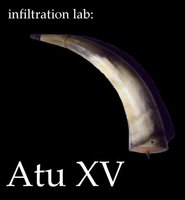 I recorded a 3" CDR during the summer and slowly mixed it into a reality sometime in September. The album is called Atu XV, and I finally managed to make it available online (also here and here). Ever since I moved back to Portland, I've been wanting to do the tour of the Shanghai Tunnels that run underneath part of downtown. Last week was the Day of the Dead, and I was fortunate enough to make it to the Soriah+Lana performance that was held in the friggin tunnels. The performance was really enjoyable, I'm certainly glad I crawled underground to be there. I emerged with an evil smirk and a renewed appreciation for the great things Portland has to offer. Last, certainly not least, the PDX Dorkbot is continuing to come together...if you live in the area, drop by one of the meetings, join the mailing list, and help us out. We're mostly looking for chairs and a projector, but we can use all other variety of goods and services. If I stop procrastinating, I'll be giving a short talk about the p5 glove and pd at the first "real" meeting.
I recorded a 3" CDR during the summer and slowly mixed it into a reality sometime in September. The album is called Atu XV, and I finally managed to make it available online (also here and here). Ever since I moved back to Portland, I've been wanting to do the tour of the Shanghai Tunnels that run underneath part of downtown. Last week was the Day of the Dead, and I was fortunate enough to make it to the Soriah+Lana performance that was held in the friggin tunnels. The performance was really enjoyable, I'm certainly glad I crawled underground to be there. I emerged with an evil smirk and a renewed appreciation for the great things Portland has to offer. Last, certainly not least, the PDX Dorkbot is continuing to come together...if you live in the area, drop by one of the meetings, join the mailing list, and help us out. We're mostly looking for chairs and a projector, but we can use all other variety of goods and services. If I stop procrastinating, I'll be giving a short talk about the p5 glove and pd at the first "real" meeting.